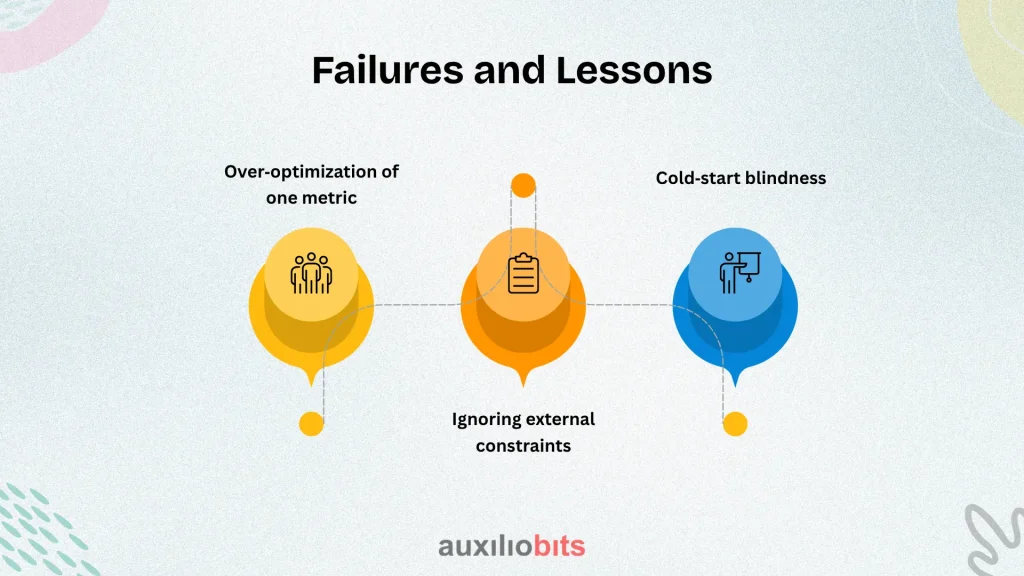
Key Takeaways
- Warehouse optimization is a constant balancing act between throughput, storage, and labor—improving one often impacts the others.
- Static rules are no longer sufficient; dynamic, agent-based systems allow real-time adjustment to demand fluctuations, workforce variability, and equipment constraints.
- Multi-agent approaches outperform monolithic models by enabling specialized decision-making across different time horizons and operational dimensions.
- Human factors are critical—agents must account for fatigue, skill levels, morale, and operational acceptance to avoid failed implementations.
- Trade-offs and governance matter—the best results come when agents illuminate options and humans decide, rather than blindly pursuing “optimal” metrics.
Talk to any distribution center manager and you’ll hear the same three words repeated like a mantra: throughput, storage, labor. Each one is measurable. Each one changes daily, sometimes hourly. And none can be maximized without sacrificing another. That’s the paradox, and it’s exactly why multi‑agent systems for warehouse optimization have become less of an academic curiosity and more of a practical survival tool.
Also read: Warehouse Task Automation: From Inbound Tracking to Dispatch
The Old Balancing Act: Static Rules in a Dynamic World
Traditionally, warehouses solved optimization problems with static priority rules. Put slow‑moving inventory up high. Store fast‑moving SKUs near the dock. Run cross‑trained pickers in 8‑hour shifts. Those heuristics work until real life intervenes. A sudden promotion surge increases demand for a niche item. A shift team calls out sick. A retailer imposes tighter order delivery SLAs.
The hard truth: static slotting and labor allocation can’t keep pace with elastic e‑commerce demand. What’s required is adaptive, agent‑based logic that learns and recalibrates repeatedly across three very different—but non‑separable—axes.
Throughput: More Than Orders Per Hour
It’s tempting to reduce throughput to “lines picked per hour.” But in modern facilities, throughput is constrained by dozens of hidden bottlenecks:
- Conveyor merges that can only handle so many cartons.
- Buffer zones near sorters clogging at peak hours.
- Packaging stations have a slower time than upstream pick rate.
- Transportation cut‑off windows—getting trucks out of the yard on time matters as much as how fast goods flow inside the four walls.
There have been operations chasing pick‑per‑hour improvements while ignoring dock congestion, only to realize the upstream gains evaporated when trailers sat idle waiting for release. Throughput agents worth their name have to model the full end‑to‑end flow, not just local sub‑tasks.
Some approaches that have been observed:
- Dynamic wave planning that adjusts release sequences every 30 minutes based on live choke points.
- Multi‑robot orchestration where autonomous mobile robots (AMRs) stagger paths to avoid merges rather than racing blindly toward them.
- Demand‑weighted picking so hot SKUs reach dockside early enough for same‑day delivery, even if that hurts raw efficiency metrics.
Throughput isn’t linear, and improvements often come from counterintuitive adjustments—slowing one sub‑system so the entire network flows better.
Storage Density and Flexibility
Every warehouse manager secretly dreams of infinite cubic space. The reality: storage and retrieval costs balloon as density rises. Push too hard on cube utilization and replenishment slows, errors rise, and labor cycles spike.
A few ground truths:
- Narrow aisles with high racking maximize density but tie you to specialized equipment and restrict throughput.
- Dynamic slotting by machine‑learning models helps, but frequent re‑slotting burns labor and confuses pickers who maintain mental maps.
- Reserve vs. forward pick tension: Do you keep larger reserves in harder‑to‑reach racks, or allocate more prime pick faces for popular SKUs at the expense of variety?
Some agent models simulate thousands of slotting decisions per night using live order forecasts. They propose rebalancing not just by velocity, but by SKU affinity—storing items often ordered together closer to reduce cross‑aisle traversal. A cosmetics 3PL I worked with saw measurable efficiency gains when lipsticks and eye liners (highly correlated in demand) were slotted adjacent, even though their individual velocities differed.
Still, density has limits. Push it too far and you trade away resilience. In Q4 peak, managers often de‑densify to create staging lanes and temporary pick modules. A clever agent understands when to recommend less utilization for the sake of throughput and labor sanity.
Labor Costs: The Wild Card
If space is physical and throughput is mechanical, labor is psychological. Labor variability is what breaks neat optimization models. Fatigue, training, absence, morale—they introduce non‑linear patterns.
An honest operator will tell you: the same workforce writes very different numbers across days. Picking agents that ignore human variability deliver plans that look great in simulations and collapse on Monday mornings after long weekends.
Ways agents are attempting to handle this:
- Productivity scoring not just on an hourly basis, but by tracking fatigue slopes over shift length, then rotating tasks (picking vs. replen vs. packing) to smooth decline.
- Shift scheduling algorithms that weigh wage rates, overtime rules, and cross‑skill coverage rather than just raw headcount.
- Training-aware planning: New hires are seeded gradually into easier zones so they don’t drag zone throughput below the acceptable floor.
There’s a controversial angle too: incentive systems. Some optimization engines build in pick targets tied to bonuses. Sounds fine until quality errors creep in from rushed workers. An agent that chases labor efficiency blind to defect costs is creating false economies. I’ve personally seen returns departments balloon after “optimized” routines were deployed without including quality rates in the cost function.
Why Multi‑Agent Systems Work Better Than Monoliths
You might ask: why agents? Why not just a single optimization engine with a giant objective function? In theory, you could blend throughput, storage, and labor into a weighted optimization problem. In practice, it collapses under complexity.
- Throughput requires minute‑by‑minute recalibration based on material handling system states.
- Storage is a slower cadence—most re‑slotting decisions are daily or weekly.
- Labor allocation runs somewhere in between, adjusting shift‑to‑shift.
Different time horizons. Different decision variables. Expecting one model to reconcile all of them often results in oversimplification. By contrast, a multi‑agent approach allows specialized solvers to run at their natural cadence, negotiating with each other via shared constraints.
A throughput agent could respond to a conveyor choke by pulling labor recommendations from the workforce allocator. Meanwhile, the storage agent might defer its re‑slotting decision until off‑peak, so it doesn’t create chaos mid‑shift. This separation of concerns reflects actual operational rhythms more faithfully.
Real Cases in Play
Consider a grocery distribution center in the U.S. Midwest. Fresh goods flow through with punishing time windows. Their previous rule set allocated pickers uniformly by department footprint. The result: surges in dairy orders would overwhelm cooler storage aisles while dry goods workers idled. After adopting a multi‑agent balancing model, labor assignments shifted hourly across departments. Labor utilization rose, and shrinkage dropped.
Another example: an apparel fulfillment operator in Germany experimented with digital twins in its warehouse. Their storage agent simulated 48 different SKU placement configurations before peak season, then instructed nightly mini‑shuffles. The agent’s proposals weren’t always intuitive—placing high‑value handbags further from dock doors to minimize shrinkage risk—but overall throughput impact was net positive, and managers valued transparency in trade‑offs.
Not all pilots shine, though. A Southeast Asian electronics distributor integrated an off‑the‑shelf optimization agent. Within weeks, the labor revolt spread. Why? The agent’s “optimal” labor allocations rotated pickers so frequently that workers lost a sense of zone ownership. Errors spiked, morale fell, and the initiative paused. Lesson: Human acceptance is as critical as mathematical elegance. Agents can balance storage, throughput, and cost—but only if operators buy the logic.
Failures and Lessons
Here are some recurring traps in warehouse optimization projects:

- Over‑optimization of one metric: There have been consultants tout 15% throughput gains, forgetting that error rates subsequently wiped out margins.
- Ignoring external constraints: Carriers impose cut‑offs, unions impose break rules, and fire marshals set aisle spacing mandates. Agents unaware of regulatory or contractual realities make unimplementable suggestions.
- Cold‑start blindness: Optimization models need historical data. When order profiles shift—as in post‑COVID e‑commerce spikes—agents trained on old data underperform until rapidly retrained.
These pitfalls don’t indict agent‑based approaches. They reveal that optimization is as much about governance and iterative calibration as about algorithms.
When To Bend Metrics
Sometimes the “optimal” answer is bending metrics—sacrificing one axis knowingly.
- During promotional spikes, some operators knowingly allow cube utilization to drop, bringing forward inventory into staging, because throughput is king during those weeks.
- In tight labor markets, managers might accept lower order‑per‑hour metrics, provided overtime costs don’t balloon.
- Warehouses under capacity constraints occasionally “burn” throughput temporarily by running longer picking routes, as it prevents expensive overflow storage contracts.
Good agents don’t blindly enforce one KPI; they highlight trade‑offs so humans can set the policy. The agent brings computational rigor, the operator brings business context.
Technology Ecosystem Around Agents
It’s worth noting: very few warehouses run purely homegrown agent frameworks. Most rely on a patchwork of vendors and systems.
- Warehouse Execution Systems (WES) that now embed micro‑services acting as local intelligent agents.
- Digital twins built on platforms like Siemens or AnyLogic, where storage agents run simulations overnight before delivering slotting guidance.
- Labor management systems integrate predictive scheduling agents, though unions often keep guardrails in place.
There’s no one‑size‑fits‑all solution. A high‑volume parcel hub may lean heavily on throughput orchestration. A cold storage facility emphasizes labor safety rotations. A fashion retailer cares deeply about storage density given SKU proliferation. Agents flex differently per vertical.
The Subtext: Human Responsibility
Zooming out, the real challenge is organizational alignment. Agents are tools, not fixes. An algorithm might find the “cheapest” labor assignment, but if it disregards employee dignity, long‑term costs skyrocket due to turnover. Likewise, pushing cube utilization might look great in CFO models but will anger warehouse floor leads who can’t find space to move pallets.
The best operators use agents not to dictate, but to illuminate trade‑offs. The system recommends; humans decide. And often, the best decision is deliberately sub‑optimal on paper but sustainable in practice.
Final Reflection
Warehouse optimization is the art of compromise, formalized through mathematics and simulation. Throughput, storage, labor—pull one lever and the others move. Static heuristics no longer suffice at scale. Agent‑based systems, if built with sensitivity to real operational dynamics, can distribute intelligence across time horizons and system nodes.
They’re messy, imperfect, and occasionally baffling—but when tuned responsibly, they create warehouses that bend rather than break when demand surges, staff shifts, or networks constrict. Which, if you’ve ever stood on a dock at 3 a.m. waiting for a truck to leave, you know, is the difference between survival and meltdown.








